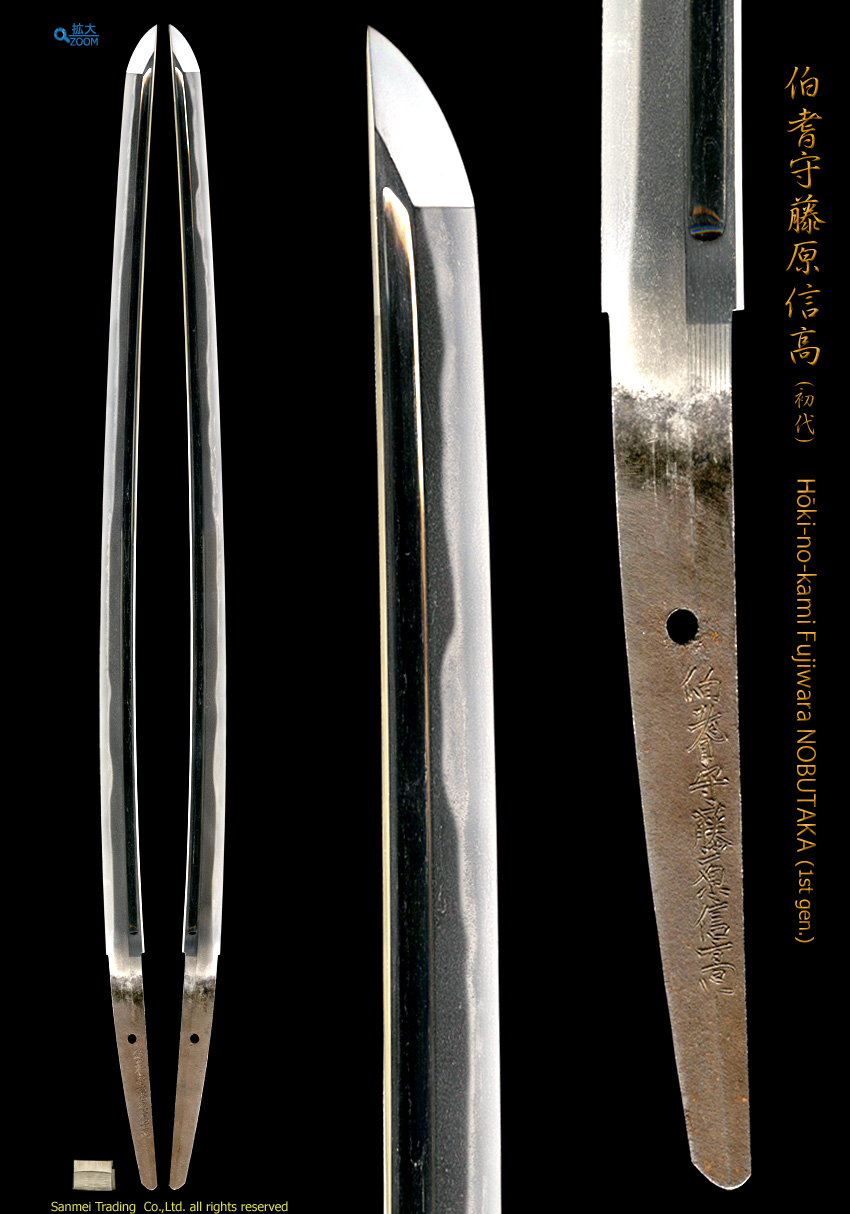NTHK(Shoshin)
Length of cutting edge 75.9cm Curvature 1.2cm Width of base 31.3mm Width of Yokote 23.1mm Thickness of base 7.5mm
Carving(Horimono): Round end Bo-hi grooves on both sides.
Forging(Hada): Forging is fine Itame-hada with an indication of Masamehada ware mostly appears along hardening area. Crystallized granule appears on surface that emits sparkling reflection of Ji-nie and abundant darkish lines from non-steel element CHIKEI appears on Hira-ji.
Temper(Hamon): Hamon is Nie hard steel crystallized large waves Notare. Sparkling visible a bit on coarse sided Nie accumulated deeply on hardening pattern. There perceives clear activities of thick Nie lines so called Inazuma and Kin-suji - curved line that runs along hardening boundary area.
Temper of tip(Boshi): Temper of boshi forms almost Ichimai whole hardening indication and large circle turns back.
Tang(Nakago): The tang is original UBU with Sujikai (slanting left) filemarks. Uneven U-shape Kurijiri heel shape. One mekugi-ana peg hole. The inscription signature in front is 7 peculiar character Houki-no-kami Fujiwara NOBUTAKA 伯耆守藤原信高. The back ridge of Nakago is flat with Sujikai (slanting left) filemarks.
Here is a posthumous work by the 1st generation Houki-no-kami Fujiwara NOBUTAKA伯耆守藤原信高, real name Koumura Saemon 河村左衛門, born in Eiroku 4 (1561), Kamiuchi town, Mino province (now Matsumori, Mino-city).
He moved to Seki-Kaji town in Kiyosu in the early years of Tensho (1573-) and stood high in master general Oda Nobunaga's 織田信長 favor and was granted the part of name Nobu 信 also obtained the official district title of Houki-no-kami 伯耆守 from the Imperial Court in Tensho 9 (1581) at the young age of 21.
He had moved to Seki-Kaji town in Owari (now in Marunouchi 3 chome, Naka-ku, Nagoya) in Nagoya castle relocation , the 2nd month, Keicho 15 (1610) in order to serve exclusively for Tokugawa Yoshinao 徳川義直, Owari Tokugawa clan.
There was large demand of swords from brave Samurais, who preferred stout and best cutting performance especially in Owari domain where Bushido was very vigorous. The smith Nobutaka proudly worked for high class Samurais in Owari and has been treasured in generations holding brave spirit.
This is a typical example of the Keicho shinto style that reminds one of Nanbokucho-revival blades which was a major refined elegance during Azuchi-Momoyama period against a dandysim of brave Samurai spirits.
Nakago holds very good taste of patina that remains clear filemark and chisel of peculiar signature by the 1st generation NOBUTAKA.
Silver double layers habaki collar, Preserved in a Shira-Saya plain wood mounting.
Good polish/Condition scale: excellent-very good (using a scale of mint-excellent-very good-good-fair-poor).
reference data:
Iwata Atou, Owari Toukoufu, 1985 Nagoya city Board of Education
Kato Hiroshi,Token Bijutsu vol.357, 1986 Japanese Sword Preservation Society


